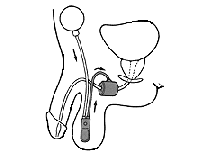|
AMS Sphincter 800 - Artificial Urinary Prosthesis (AUS)
Illustrations and text from AMS. This is not an endorsement or recommendation which can come only from your physician. Phoenix5 has no affiliation with AMS and receives no compensation. This is presented for education only.
A first-person account is also at this site.
|
|
The AMS Sphincter 800™ Urinary Prosthesis consists of three components: a cuff that applies pressure to the urethra to keep it closed; a balloon that controls the amount of pressure exerted by the cuff; and a control pump that facilitates transfer of fluid to and from the cuff. The three parts are connected by tubing and filled with saline solution or a contrast medium.
|
 |
| To empty the bladder, squeeze and release the pump, located in the scrotum. This moves the fluid out of the cuff and into the pressure-regulating balloon. Because the empty cuff is no longer pressing the urethra closed, the urine can flow out from the bladder. |
 |
| Several minutes after the bladder is empty, the fluid automatically returns from the pressure-regulating balloon to the cuff, once again squeezing the urethra closed. |
 |
Considerations:
Need for Manual Dexterity
The AUS prosthesis requires some manual dexterity and strength to operate the pump, which controls the prosthesis.
Possibility of Malfunction
The possibility of leakage, blockage, or other device malfunction exists.
Possibility of Infection
Contact your doctor immediately if there is redness, swelling, and/or heat around the incision area or drainage from the incision. This may indicate infection.
Possibility of Erosion
Contact your doctor immediately if there is thinning of skin or tissue over the prosthesis. This may indicate erosion. Failure to treat erosion can make it worse and lead to infection and loss of urine.
Possibility of Migration
Contact your doctor if the surface or any part of your device is visible through the skin or if you cannot locate the control pump. These symptoms indicate that a part of your device may have moved within your body or may be moving to the outside of your body.
Pain
Contact your doctor if you have pain that is very severe or if it lasts longer than expected. Such pain may be a symptom of a medical complication or mechanical malfunction.
Will my prosthesis have to be replaced?
It is not possible to predict how long an implanted prosthesis will function in a particular patient. As with any biomedical prosthesis, this device is subject to wear and eventual failure over time and should not be considered a lifetime implant. Product wear, component disconnection or other mechanical problems may lead to the device not functioning as intended and may lead to additional surgery to replace the device. Discuss any changes you notice in the function of your prosthesis with your doctor.
Illustrations and text from AMS. This is not an endorsement or recommendation which can come only from your physician.
A first-person account is also at this site.
|
|